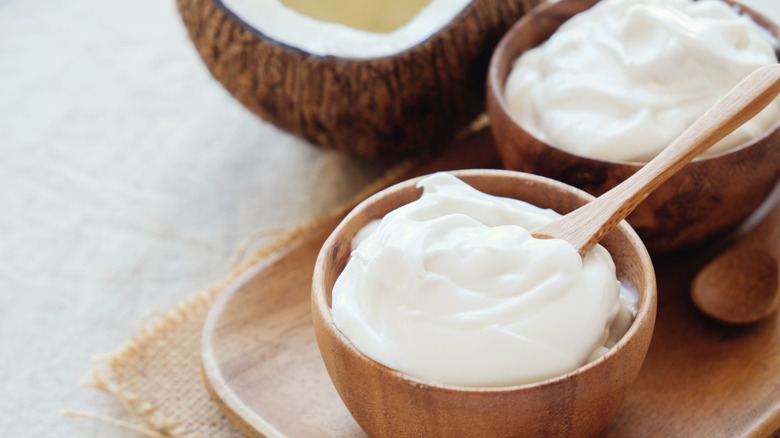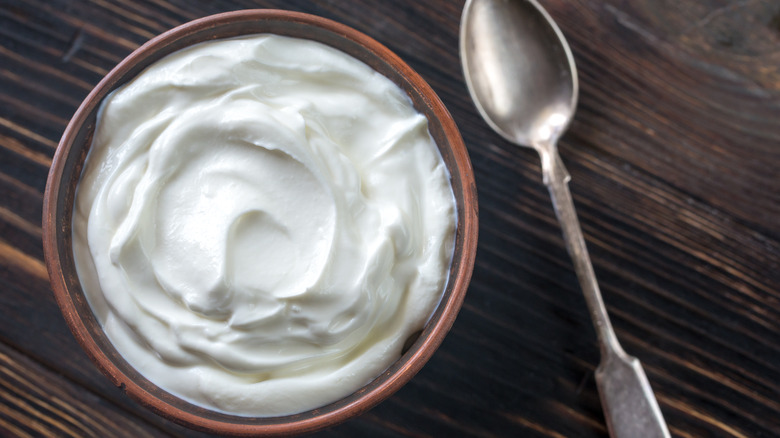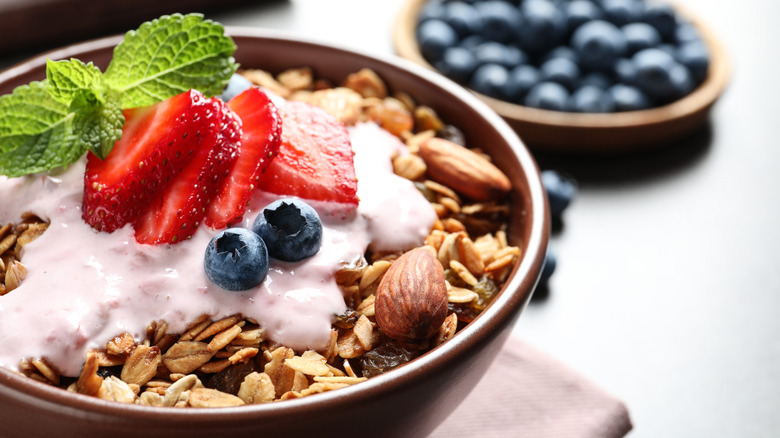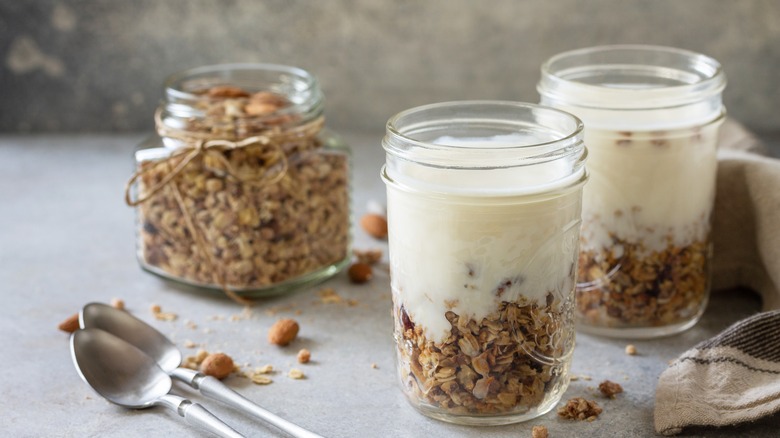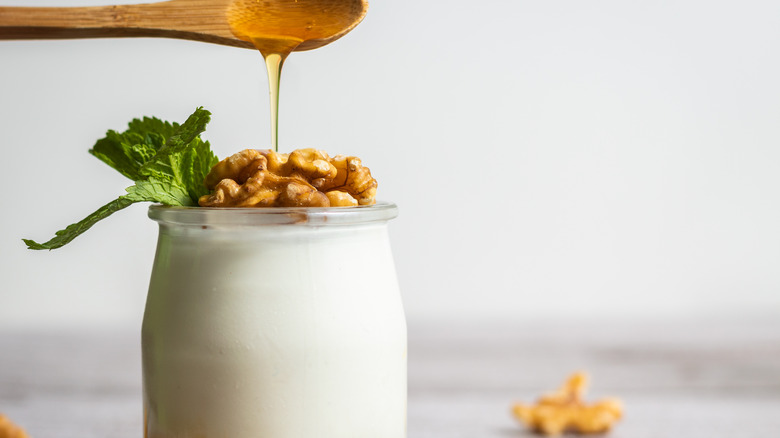What Makes Australian Yogurt Unique?
Yogurt is a lovely, versatile dairy product that can be eaten as is, added to smoothies as a thickening agent, turned into desserts, and more. Historians have traced yogurt as far back as 5,000 B.C. in Mesopotamia, according to Medium, and it was used as a way to preserve excess milk.
You may be loyal to one brand or flavor of yogurt, but there are many varieties to explore. In the U.S., cow's milk yogurt is the most popular (per Statista), but yogurt can also be made from goat milk, sheep milk, and non-dairy milk, via Cultures for Health. The variety doesn't stop there, because even if the same milk is used, different regions of the world have learned to make yogurt in different ways, leading to a multitude of textures and tastes on store shelves.
Some yogurts you may have seen or eaten include traditional unstrained yogurt, Greek yogurt, ultra creamy Icelandic skyr, and Australian yogurt, lists Thrillist. Keep reading to learn more about the lesser-known, but just as delicious, Australian yogurt.
What is Australian yogurt and how is it made?
Different parts of the globe have their own unique ways of making yogurt. Australian yogurt is lumped in with Greek yogurt and skyr because it is also thicker compared to American yogurt, but the reason is quite different. Greek yogurt and skyr are both thick because all the liquid is strained out, unlike American or French yogurt, per The Dairy Alliance.
Australian yogurt is unstrained, but it's nearly as thick as Greek yogurt. This is because it cooks slower and a lot longer than unstrained yogurts, so the dairy has a chance to naturally thicken over time. The two most popular and widely commercially available Australian yogurts, Noosa and Wallaby, use different milks, sweeteners, and cook times, which give them slightly different tastes and textures.
Making Australian yogurt starts out similarly to most yogurts. As Food Crumbles explains, yogurt is generally made by introducing small amounts of bacteria that ferment the milk in a process called lactic acid fermentation. The bacteria turn lactose sugars into lactic acid, which thickens the milk and gives it that signature sour taste.
The end result of this more traditional yogurt making method results in something very liquidy, though certainly thicker than milk. Australian yogurt, though, has a longer culture and cooking process, which gives it a much thicker, creamier consistency compared to regular yogurt (via Wallaby).
What does Australian yogurt taste like?
Noosa, one of the more popular producers of Australian yogurt, describes the texture of its yogurt as velvety. The brand also sweetens all of its flavored yogurts with honey, and then adds fruit to create a variety of flavors. The company also has a plain tart flavor that has the basic, tangy flavor that most yogurts are known for (via The Dairy Alliance). Another reputable Australian yogurt company, Wallaby, describes its yogurt as having a mild taste. The brand also has plain, vanilla, and fruit-flavored Australian yogurts available for purchase.
According to Thrillist, the flavor of Australian yogurt is slightly unique since it's flavored with honey — Noosa, at least. That's also assuming you're getting a flavored yogurt — plain Australian yogurt will have the classic, tart and sour flavor Greek and traditional yogurts are known for. The difference lies in the texture — if there were a scale of thickness and creaminess for various yogurts, traditional yogurt would be on the bottom, followed by Australian yogurt, then Greek, and finally Icelandic skyr.
How to cook with it
The neutral, slightly tangy and sour flavor profile of yogurt lends itself well to both savory and sweet dishes, and Australian yogurt is no exception. It's described as being even creamier than regular strained yogurt, and not quite as thick as Greek yogurt, so it's even more versatile. Bon Appétit recommends adding a dollop of yogurt to garnish a soup, spreading it on toast, serving it with fresh fruit, using it as a mayonnaise substitute, or adding it to a marinade.
Wallaby has a whole page on its website dedicated to recipes using Australian yogurt, including smoothie bowls, a pepper dip, yogurt bark, banana mousse, ice cream sandwiches, za'atar yogurt dip, and a citrus chili pepper marinade, to name a few. Flavored Australian yogurts are good as is, or added to a smoothie, smoothie bowl, or adding a tart contrast to your favorite dessert.
Where to buy Australian yogurt
Australian yogurt is quite easy to find at most major grocery stores. It will likely be found in the dairy aisle, alongside basic yogurts and Greek yogurts. You likely won't find it in world or international food aisles — it'll be conveniently located with the rest of your favorite yogurts. Two of the most popular producers of Australian yogurt are Noosa and Wallaby, so look for those product names and packaging.
If you're having a hard time finding Australian yogurt at your local grocery stores, Noosa has a product locator on its website. All you have to do is select the product or products you're looking for, type in your location, and it'll track it down in person or online. Wallaby has a similar product locator on its website. Amazon also sells Noosa and Wallaby Australian yogurts for delivery or pick up through Whole Foods, as long as it's in stock at a store near you.
Nutritional information
The nutritional facts for Australian yogurt differ company by company, whether it's flavored or not, etc., but it is generally as nutritionally beneficial as all yogurt. Different people have different takes on the health benefits, or lack thereof, of yogurt — it's full of probiotics and calcium, but lots of commercial yogurts have added sugars and artificial sweeteners, per Medical News Today. Of course, if you're lactose intolerant, dairy products in general aren't nutritionally beneficial.
One serving of Noosa's plain yogurt has 190 calories, 10 grams of fat, 10 grams of protein, and 11 grams of natural sugars — its plain yogurt doesn't contain honey. It also has 40 milligrams of cholesterol, 105 milligrams of sodium, and 12 grams of carbs, as well as calcium and potassium. Noosa adds kosher gelatin to their mixture, so vegetarians should steer clear.
Wallaby has multiple products, including low and nonfat options. The brand's regular, plain Australian yogurt, though, is made of just whole milk with added cultures — no gelatin, pectin, or other additives. One serving of yogurt has 130 calories, 6 grams of fat, 20 milligrams of cholesterol, 90 milligrams of sodium, 10 grams of carbs, 8 grams of natural sugar, 8 grams of protein, 320 milligrams of calcium, 420 milligrams of potassium, and a small amount of vitamin D.
All in all, if you're trying to add a healthy snack or breakfast to your routine, Australian yogurt is a solid choice.
